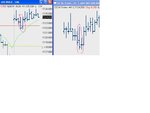clylbw
Well-known member
- Messages
- 454
- Likes
- 4
Hi,
I day trade US index futures on margin and wonder how I may hedge my exposure.
I was not in the market on September 11st, but I take it that immediately after the attack the market was closely until the next day. When it was finally re-opened, the market collapsed.
Therefore, If I were long in the market intra-day and something like the September 11st happened, which I believe is not so unlikely, the market were closed immediately. When it re-opened, it collapsed, and I could lose all my trading capital or even more with leverage. Even if I had set stops, the stops could remain unfilled untill the market were much lower.
How can I prevent such >100% loss of capital from happening?
Many thanks indeed.
I day trade US index futures on margin and wonder how I may hedge my exposure.
I was not in the market on September 11st, but I take it that immediately after the attack the market was closely until the next day. When it was finally re-opened, the market collapsed.
Therefore, If I were long in the market intra-day and something like the September 11st happened, which I believe is not so unlikely, the market were closed immediately. When it re-opened, it collapsed, and I could lose all my trading capital or even more with leverage. Even if I had set stops, the stops could remain unfilled untill the market were much lower.
How can I prevent such >100% loss of capital from happening?
Many thanks indeed.

